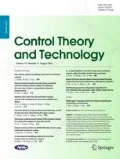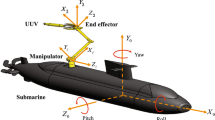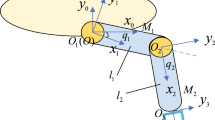Abstract
In this paper, an adaptive nonsingular fast terminal sliding mode control (ANFTSMC) is proposed for underwater manipulator robotics with asymmetric actuator saturations and unknown time-varying (TV) external disturbances. Firstly, the nonsingular fast terminal sliding mode (NFTSM) control scheme is conducted for the underwater manipulator robotics, which guarantees the boundedness of all the signals in the control system. Secondly, the adaptive method and the smooth hyperbolic tangent (tanh) function are introduced to address the unknown TV external disturbances and the input saturation errors. Thus the prior knowledge about the upper bounds of the system uncertainties is not needed in this paper. To deal with the nonlinear asymmetric input saturation issue, a Gaussian error function is employed in the asymmetric saturation module so that the discontinuous input signals can be transformed into smooth forms. Thirdly, the rigorous mathematical verification is conducted to demonstrate the stability and finite-time convergence of the closed-loop control system via the Lyapunov theory. Finally, numerical simulations are performed on a two-link underwater manipulator robotic system to illustrate the effectiveness of the proposed controller.
Similar content being viewed by others
References
Z. Xiao, G. Xu, F. Peng, et al. Development of a deep ocean electric autonomous manipulator. China Ocean Engineering, 2011, 25(1): 159–168.
Z. Chu, X. Xiang, D. Zhu, et al. Adaptive fuzzy sliding mode diving control for autonomous underwater vehicle with input constraint. International Journal of Fuzzy Systems, 2018, 20(5): 1460–1469.
D. Kim, H. S. Choi, J. Y. Kim, et al. Trajectory generation and sliding-mode controller design of an underwater vehicle-manipulator system with redundancy. International Journal of Precision Engineering and Manufacturing, 2015, 16(7): 1561–1570.
G. Xu, Z. Xiao, Y. Guo, et al. Trajectory tracking for underwater manipulator using sliding mode control. IEEE International Conference on Robotics and Biomimetics (ROBIO), Sanya: IEEE, 2007: 2127–2132.
D. S. Kwon, J. H. Ryu, P. M. Lee, et al. Design of a teleoperation controller for an underwater manipulator. IEEE International Conference on Robotics and Automation, San Francisco: IEEE, 2000: 3114–3119.
L. Wang, C. Wang, W. Wang, et al. A novel hybrid control method for the underwater manipulator. International Workshop on Education Technology and Training & International Workshop on Geoscience and Remote Sensing, Shanghai: IEEE, 2008: 790–794.
M. Lee, H. S. Choi. A robust neural controller for underwater robot manipulators. IEEE Transactions on Neural Networks, 2000, 11(6): 1465–1470.
A. C. Huang, Y. C. Chen. Adaptive sliding control for singlelink flexible-joint robot with mismatched uncertainties. IEEE Transactions on Control Systems Technology, 2004, 12(5): 770–775.
Y. Wang, F. Yan, J. Chen, et al. Continuous nonsingular fast terminal sliding mode control of cable-driven manipulators with super-twisting algorithm. IEEE Access, 2018, 6: 49626–49636.
S. T. Venkataraman, S. Gulati. Control of nonlinear systems using terminal sliding modes. Proceedings of the American Control Conference, Chicago: IEEE, 1992: 891–893.
Z. Man, A. P. Paplinski, H. R. Wu. A robust MIMO terminal sliding mode control scheme for rigid robotic manipulators. IEEE Transactions on Automatic Control, 1994, 39(12): 2464–2469.
L. Wang, T. Chai, L. Zhai. Neural-network-based terminal sliding-mode control of robotic manipulators including actuator dynamics. IEEE Transactions on Industrial Electronics, 2009, 56(9): 3296–3304.
A. T. Vo, H. Kang. An adaptive terminal sliding mode control for robot manipulators with non-singular terminal sliding surface variables. IEEE Access, 2019, 7: 8701–8712.
Y. Wang, K. Zhu, F. Yan, et al. Adaptive super-twisting nonsingular fast terminal sliding mode control for cable-driven manipulators using time-delay estimation. Advances in Engineering Software, 2019, 128: 113–124.
L. Qiao, W. Zhang. Adaptive second-order fast nonsingular terminal sliding mode tracking control for fully actuated autonomous underwater vehicles. IEEE Journal of Oceanic Engineering, 2019, 44(2): 363–385.
C. J. Fallaha, M. Saad, H. Y. Kanaan, et al. Sliding-mode robot control with exponential reaching law. IEEE Transactions on Industrial Electronics, 2011, 58(2): 600–610.
H. Lee, V. I. Utkin. Chattering suppression methods in sliding mode control systems. Annual Reviews in Control, 2007, 31(2): 179–188.
Y. Wang, F. Yan, K. Zhu, et al. A new practical robust control of cable-driven manipulators using time-delay estimation. International Journal of Robust Nonlinear Control, 2019, 29(11): 3405–3425.
Y. Wang, J. Chen, F. Yan, et al. Adaptive super-twisting fractional-order nonsingular terminal sliding mode control of cable-driven manipulators. ISA Transactions, 2019, 86: 163–180.
Z. P. Jiang, L. Praly. Design of robust adaptive controllers for nonlinear systems with dynamic uncertainties. Automatica, 1998, 34(7): 825–840.
X. Wang, X. Yin, Q. Wu, et al. Disturbance observer based adaptive neural control of uncertain MIMO nonlinear systems with unmodeled dynamics. Neurocomputing, 2018, 313: 247–258.
S. Tong, C. Liu, Y. Li. Fuzzy-adaptive decentralized outputfeedback control for large-scale nonlinear systems with dynamical uncertainties. IEEE Transactions on Fuzzy Systems, 2010, 18(5): 845–861.
J. Baek, M. Jin, S. Han. A new adaptive sliding-mode control scheme for application to robot manipulators. IEEE Transactions on Industrial Electronics, 2016, 63(6): 3628–3637.
L. Qiao, W. Zhang. Adaptive non-singular integral terminal sliding mode tracking control for autonomous underwater vehicles. IET Control Theory & Applications, 2017, 11(8): 1293–1306.
L. Qiao, W. Zhang. Double-loop integral terminal sliding mode tracking control for UUVs with adaptive dynamic compensation of uncertainties and disturbances. IEEE Journal of Oceanic Engineering, 2019, 44(1): 29–53.
J. Wu, J. Zhao, D. Wu. Indirect adaptive robust control of nonlinear systems with timeâ€varying parameters in a strict feedback form. International Journal of Robust Nonlinear Control, 2018, 28(13): 3835–3851.
W. He, Y. Dong, C. Sun. Adaptive neural impedance control of a robotic manipulator with input saturation. IEEE Transactions on Systems, Man, and Cybernetics: Systems, 2016, 46(3): 334–344.
M. Spong, J. Thorp, J. Kleinwaks. The control of robot manipulators with bounded input. IEEE Transactions on Automatic Control, 1986, 31(6): 483–490.
E. Aguinaga-Ruiz, A. Zavala-Rio, V. Santibanez, et al. Global trajectory tracking through static feedback for robot manipulators with bounded inputs. IEEE Transactions on Control Systems Technology, 2009, 17(4): 934–944.
M. Chen, B. Jiang, J. Zou, et al. Robust adaptive tracking control of the underwater robot with input nonlinearity using neural networks. International Journal of Computational Intelligence Systems, 2010, 3(5): 646–655.
J. Ma, S. S. Ge, Z. Zheng, et al. Adaptive NN control of a class of nonlinear systems with asymmetric saturation actuators. IEEE Transactions on Neural Networks and Learning Systems, 2015, 26(7): 1532–1538.
Z. Zheng, C. Jin, M. Zhu, et al. Trajectory tracking control for a marine surface vessel with asymmetric saturation actuators. Robotics and Autonomous Systems, 2017, 97: 83–91.
P. Van Cuong, W. Y. Nan. Adaptive trajectory tracking neural network control with robust compensator for robot manipulators. Neural Computing and Applications, 2016, 27(2): 525–536.
K. Ioi, K. Itoh. Modelling and simulation of an underwater manipulator. Advanced Robotics, 1989, 4(4): 303–317.
S. McMillan, D. E. Orin, R. B. McGhee. Efficient dynamic simulation of an underwater vehicle with a robotic manipulator. IEEE Transactions on Systems, Man, and Cybernetics, 1995, 25(8):1194–1206.
M. M. Polycarpou, P. A. Ioannou. A robust adaptive nonlinear control design. Automatica, 1996, 32(3): 423–427.
P. Jia. Research on Grasp Planning and Optimization of Grasping Forces for Robotic Dexterous Hands. Harbin: Harbin Engineering University, 2011 (in Chinese).
Author information
Authors and Affiliations
Corresponding author
Additional information
This work was supported by the National Natural Science Foundation of China (No. 51979116), the HUST Interdisciplinary Innovation Team Project, the Innovation Foundation of Maritime Defense Technologies Innovation Center and the Fundamental Research Funds for the Central Universities (HUST: 2018JYCXJJ045, HUST: 2018KFYYXJJ012).
Zengcheng ZHOU received the B.Sc. degree in Marine Engineering from Huazhong University of Science and Technology, Wuhan, China, in 2017. He is currently pursuing a M.Sc. degree with the School of Naval Architecture and Ocean Engineering, Huazhong University of Science and Technology. His current research interests include the nonlinear control, sliding mode control and underwater vehicles and manipulators.
Guoyuan TANG received the Ph.D. degree from Mechanical Science and Engineering from Huazhong University of Science and Technology, Wuhan, China, in 2005. He is an associate professor of School of Naval Architecture and Ocean Engineering of Huazhong University of Science and Technology. His research interests include control of underwater robots (vehicles) and manipulators, ocean intelligent systems, control of marine unmanned clusters. He serves as a reviewer for some peer-reviewed journals, including Ocean Engineering, Journal of Marine Science and Application.
Hui HUANG received the M.Sc. degree in Solid Mechanics from Huazhong University of Science and Technology (HUST), Wuhan, China, in 2018. He is currently a Ph.D. candidate at School of Naval Architecture and Ocean Engineering, HUST under the supervision of Prof. Guoyuan Tang and Prof. De Xie. His research interests include robust control of underwater vehicles and multi-link flexible manipulators.
Lijun HAN received the B.Sc. degree in Mathematics from Xinyang Normal University, Henan, China, in 2013. Since 2014, she studied for the M.Sc. degree in Mathematics, and from 2015 worked toward the Ph.D. degree in School of Naval Architecture and Ocean Engineering from Huazhong University of Science and Technology, Hubei, China. Her research interests include robust control of underwater vehicles and manipulators.
Ruikun XU received the B.Sc. degree in Mathematics from Anqing Normal University, Anqing, China, in 2014. From 2014 to 2015, he started pursuing the M.Sc. degree in School of Mathematics and Statics, Huazhong University of Science and Technology (HUST) under the supervision of Prof. Bin Liu. He is currently a Ph.D. candidate at the School of Naval Architecture and Ocean Engineering, HUST under the supervision of Prof. Guoyuan Tang and Prof. De Xie. His research interests include the tracking control, nonlinear control, sliding mode control and underwater vehicle control.
Rights and permissions
About this article
Cite this article
Zhou, Z., Tang, G., Huang, H. et al. Adaptive nonsingular fast terminal sliding mode control for underwater manipulator robotics with asymmetric saturation actuators. Control Theory Technol. 18, 81–91 (2020). https://doi.org/10.1007/s11768-020-9127-0
Received:
Revised:
Accepted:
Published:
Issue Date:
DOI: https://doi.org/10.1007/s11768-020-9127-0




